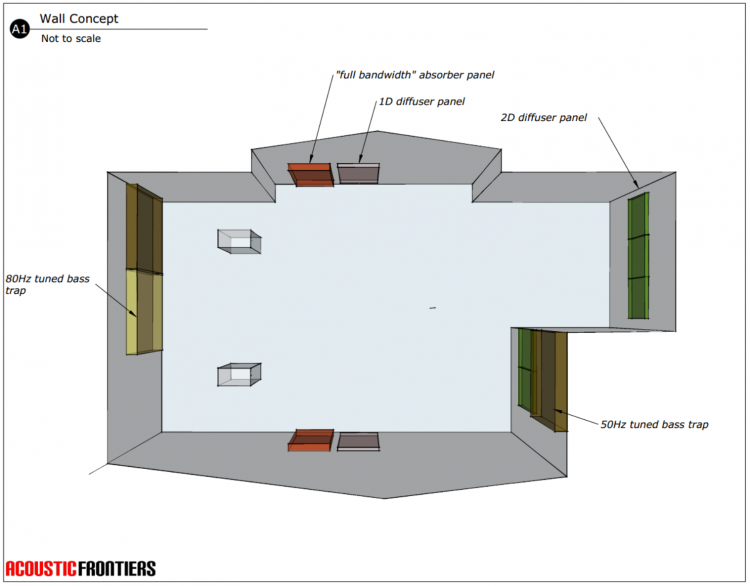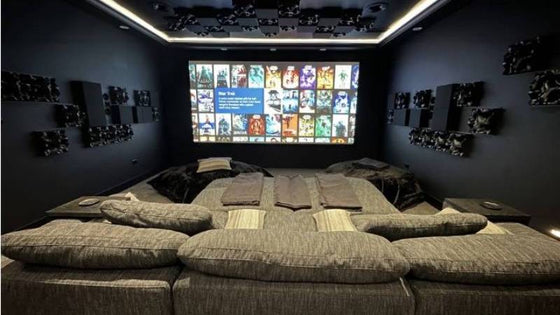Creating a system you love shouldn't be difficult. The Acoustic Frontiers blog is here to help.

Mr. Green is a high end audio enthusiast living in the Los Angeles area.
His combined two channel and home theater system was quite complex with a lot of components including a single JL Audio F112 subwoofer, a JL Audio CR1 crossover, as well as different Dali speakers for two channel and home theater.
Mr. Green had purchased and tried to use various acoustic measurement packages including Fuzzmeasure and Room EQ Wizard and had experimented with acoustical panels as well as integrating his subwoofer, but wanted professional assistance with acoustic treatment and system set-up.
The analysis process involved working with the client to take acoustic measurements and then analyzing these to determine the root causes of the acoustical issues and potential solutions.
The analysis phase took a little longer than usual as Mr. Green's room is a very odd shape. After we identified resonance issues at 50Hz and 80Hz in the individual speaker measurements, we asked Mr. Green to "map" the areas of high sound pressure, in order to find the best place for diaphragmatic bass traps. Diaphragmatic bass traps, unlike porous traps, work on the pressure component of sound and are very effective close to room boundaries. Porous traps such as the ubiquitous fiberglass, work best when velocity is high, which is actually away from room boundaries.
Acoustic treatment design involved specifying the number and type of tuned bass traps from RealAcoustix - the BassMod4848. We also specified Kinetics Versatune for the immediate reflection points (the side wall reflection was too close to use a hybrid absorber / diffuser or pure diffuser) and custom fabric wrapped Listen Audio Diffuse Signature diffusion panels for most other reflection points. We also specified a few Kinetics TAD panels on the ceiling - careful ray tracing was required to find the reflection points due to the complex ceiling geometry.

Acoustic treatment concept

We also swapped out the single JL Audio F112 subwoofer for a pair of JL Audio F110v2, placing one front right corner and one on the back wall. These subwoofers were an integral part of the design, since they cancelled the 1st axial length mode at 23Hz, and also provided the superior DARO room correction implementation.
After the room acoustics were installed, the client was hungering for more from his system. We advised him that speakers would be the biggest upgrade. He auditioned the ATC SCM40, SCM40A and SCM50A and was blown away by our active anniversary SCM50, ordering a pair right away.

ATC SCM50ASL
Acoustic Frontiers delivered the new speakers and performed positional optimization and set-up of the subwoofers and JL Audio CR1 crossover. The CR-1 settings arrived at were not obvious...note the large difference between the sub and sat crossover frequencies! Setting the system up this way further minimized excitation of the 80Hz resonance, and improved sound quality.
Here are the post calibration measurements for the bass range below 300Hz - note the huge difference in the whole bass region under 100Hz and the complete elimination of the 23Hz and 43Hz resonances.

Pre vs post <100Hz frequency response, 1/12th smoothing
Also look at the huge reduction in the level of reflections in the first 40ms after the direct sound. This was achieved with only a 0.25s reduction in the reverberation time (T60), so the room did not sound over-treated and lifeless, like many treated rooms do.
Managing reflections primarily through diffusion and hybrid absorber / diffusers, with spot application of high performance absorption, is our preferred approach to improving room acoustics.

Pre vs post energy time curve (ETC)
Learn how early home theater design, layout, and acoustic treatment improve performance in new home construction.
This media room was intentionally designed to feel like part of the home—not a separate, tech-heavy space. Through careful acoustic planning, equipment integration, and final calibration, we achieved a room that is both beautiful to live in and immersive to experience.
"No other subwoofer system I’ve owned even comes close to what this room delivers. Reaching out to Acoustic Frontiers was one of the best decisions I’ve made—I highly recommend working with them if you want to get the most out of your theater."

Nyal Mellor, Founder, Acoustic Frontiers



Nyal Mellor
Author